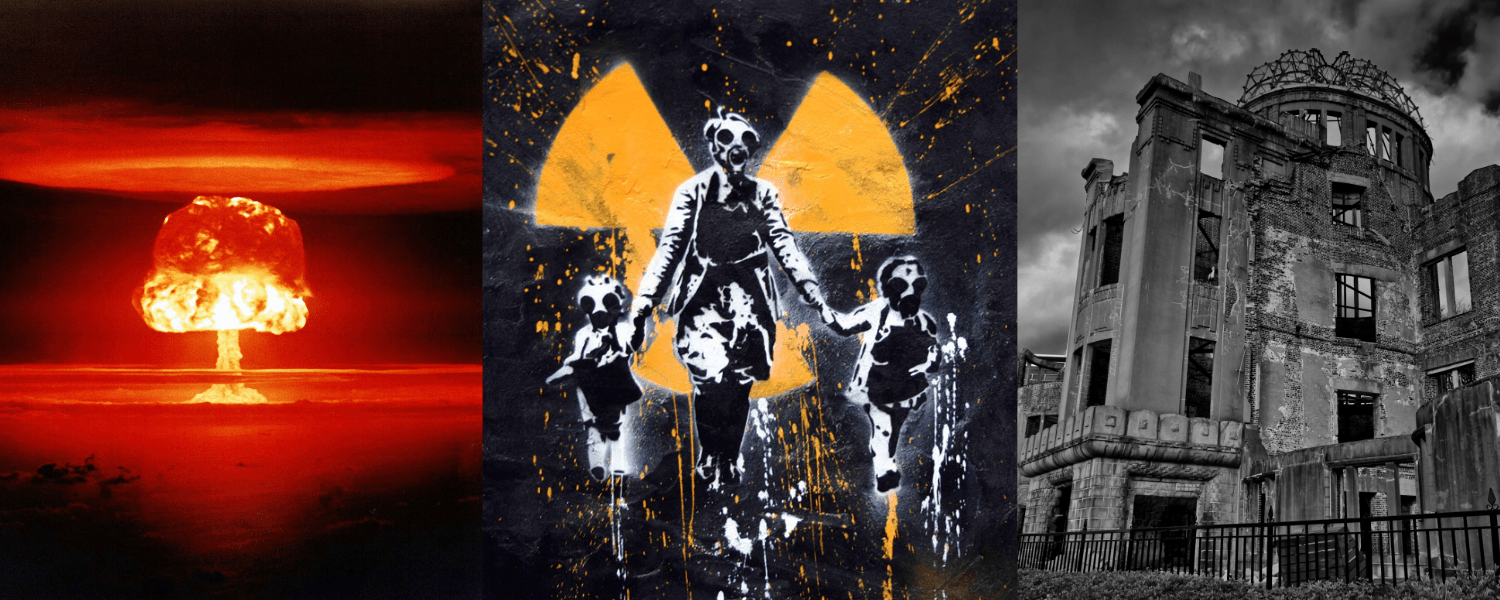“I know not with what weapons World War III will be fought, but World War IV will be fought with sticks and stones.” -Albert Einstein
Nuclear war is coming. It is only a matter of when.
In the past few years, North Korea has successfully tested nuclear weapons, adding itself to the short list of nine countries with nuclear capabilities. Recent posturing between North Korean President Kim Jong-Un and Donald Trump has escalated tension between these two nuclear powers.
Aggressive sanctions have failed to put a halt to North Korea’s weapons program, leading Trump to threaten a move to “phase two” of US strategy, which is suspected to reference military options. Could such escalation result in the deployment of nuclear weapons?
Meanwhile, Russia is responding to US talk of bulking up its nuclear arsenal by developing new nuclear weapons that could overcome missile defense systems: cruise missiles with nuclear-propulsion engines that would have unlimited range and unpredictable flight paths.
Given the growing tension between various nuclear powers, it’s no surprise that the Bulletin of Atomic Scientists decided to move up their “doomsday clock” at the start of 2018. It now sits at just two minutes before midnight.
The last time it was so close to midnight was in 1953, when both the US and Russia developed and tested the hydrogen bomb during the early years of the Cold War.1
In other words, the world’s vulnerability to nuclear disaster is alarmingly high.
****
There are literally thousands of nuclear warheads around the world right now (nearly 10,000 in military arsenals). The US and Russia alone maintain a combined 1,800 nuclear weapons on high-alert status, which can be launched within minutes. Nuclear-equipped missiles are primarily aimed at major cities with military bases, important industries and large airports. It’s not unlikely that this includes the very city where you are reading this article.
Have you ever thought about the nuclear weapons pointed your way? It’s not as tangible as a stranger holding a gun to your forehead, but the threat is equally real and life threatening. We need to think more about this and the danger it presents.
The picture is a dark one, but we need to remind ourselves of the terrifying reality of what nuclear war would look like. Over 70 years have past since the dropping of the bombs during World War II, so the reality of nuclear weapons is increasingly distant and unfamiliar.2 Younger generations have no memories of duck and cover drills in elementary school.
A denoted nuclear bomb would bring both instant and prolonged devastation. Men, women, children: the impact of a nuclear bomb does not discriminate among its victims. Those in the immediate vicinity will be vaporized instantly or exposed to radiation that will kill them in a few weeks or less. Others will die as buildings crumble on top of them. Further from the blast zone, victims will experience extreme burns as even their clothes catch fire.
Beyond the immediate destruction, long term effects can be even more destructive. If a series of nuclear weapons are detonated, the resulting smoke would enter the atmosphere, spread across the globe and initiate a nuclear winter. The sun’s light would be obscured, temperatures would plummet, plants would die off, and massive famine would sweep across the world.
Our planet has seen this before: the nuclear winter would essentially imitate the fallout of the asteroid strike that killed the dinosaurs.
Is such a scenario farfetched? A regional nuclear conflict just between India and Pakistan, for example, would be enough to bring about such a nuclear winter that could wipe out an estimated 90% of the world population.
****
So why do we still have nuclear weapons anyway?
We have witnessed their devastating impact. We have signed treaties to ban above ground testing and further nuclear buildup. Just last year, the United Nations negotiated a treaty to ban nuclear weapons with the goal of leading to their total elimination.
And yet…
In this year’s State of the Union address, President Trump spoke directly about nuclear weapons. But it didn’t have to do with disarmament.
As part of our defense, we must modernize and rebuild our nuclear arsenal, hopefully never having to use it, but making it so strong and powerful that it will deter any acts of aggression. Perhaps someday in the future there will be a magical moment when the countries of the world will get together to eliminate their nuclear weapons. Unfortunately, we are not there yet.
Deterrence continues to be the argument for maintaining a nuclear arsenal. If someone has a gun pointed against your forehead, they will be less likely to pull the trigger if you have a gun pointed against their forehead as well (or so the theory goes). Mutually assured destruction.
In his 1963 encyclical Pacem in Terris (“Peace on Earth”), Pope John XXIII expressed alarm at the “common belief that under modern conditions peace cannot be assured except on the basis of an equal balance of armaments” (110). He rightly assessed that this belief incentivizes nuclear development. “If one country is equipped with atomic weapons, others consider themselves justified in producing such weapons themselves, equal in destructive force” (110).
The deterrence argument not only justifies the maintenance and strengthening of a US nuclear arsenal, as Trump asserts. It also provides the logic behind nuclear development in countries like North Korea and Iran. If deterrence prevents attacks, possession of nuclear arms ensures peace. Right?
We shouldn’t be surprised that these countries are breaking treaties and ignoring sanctions to continue their pursuit of nuclear weapons. We typically assume their motives are malicious, but couldn’t they just be buying into our very own deterrence argument to ensure peace for their citizens?
*****
Nuclear weapons promote peace? It sounds silly to even make that claim.
Pope Francis cut right through that argument in an address last year:
International relations cannot be held captive to military force, mutual intimidation, and the parading of stockpiles of arms. Weapons of mass destruction, particularly nuclear weapons, create nothing but a false sense of security. They cannot constitute the basis for peaceful coexistence between members of the human family, which must rather be inspired by an ethics of solidarity.
Any peace or security we get from the possession of nuclear weapons is misleading. First of all, we live in constant risk of accidental nuclear warfare. In 1983, for example, Soviet Lt. Colonel Stanislav Petrov averted nuclear holocaust by ignoring protocol when the Soviet defense system falsely indicated that the US had launched nuclear weapons. By following his own reasoning and conscience, Petrov might have literally saved the world.
Additionally, the assumption of the deterrence argument is that neither party wants to be destroyed. But as the example of modern suicide bombers teach us, there are people in our world who act without fear of their own destruction. The more nuclear weapons in the world, the more possible it is that even one of those weapons falls into the hands of someone ideologically bent on bringing about total destruction without regard for the consequences.3 In such a situation, no theory of deterrence will keep the peace.
As long as nuclear weapons exist, there remains the threat that they will be deployed. Over enough time, it no longer becomes a question of “if” nuclear weapons will be used again, but “when.” It might not be for a hundred years (or several hundred years even!). But as long as nuclear weapons are around, nuclear war is looming.
****
Is there anything we can do? Can nuclear war be avoided?
In short, yes. But it is will require drastic global change, a “magical moment” as Trump himself called it in the State of Union.
The truth is: we need to get rid of ALL nuclear weapons. All 10,000+ of them. Anything less will not be enough.
This will require the voices of many united together. To begin, we need a conversion of our own hearts as we see the contradictions in the deterrence argument and realize the existential threat of nuclear weapons. We need to be courageous and hopeful, even in the face of the seemingly impossible. And we need to join our voices with others, for it is only together that we will eradicate the world of nuclear weapons.
As Pope John XXIII pointed out in 1963, “unless this process of disarmament be thoroughgoing and complete, and reach men’s very souls, it is impossible to stop the arms race, or to reduce armaments, or—and this is the main thing—ultimately to abolish them entirely.” It must reach to our very souls, and from there it must spread.
We have reason to hope. Last year’s UN Treaty on the Prohibition of Nuclear Weapons was passed through the combined efforts of various humanitarian initiatives, led by a coalition of non-governmental organizations that belong to the International Campaign to Abolish Nuclear Weapons (ICAN).
A well known Christian-based anti-nuclear movement is the Plowshares Movement, first founded by the late-Jesuit Daniel Berrigan, his brother Philip and six others. They famously broke onto a nuclear missile facility in 1980 and damaged the nose cones of nuclear warheads, imitating the call in Isaiah to “beat their swords into plowshares” (Is 2:4).
Global Zero is another such movement that is advocating for the elimination of nuclear weapons, with the backing of 300 global leaders and scientific experts who optimistically hope to eliminate all nuclear weapons by 2030.
So don’t just sit there with a nuclear warhead pointed your way: do something. Join a movement. Organize your own church group. Consider this issue when you vote in elections. Talk to your legislators and tell them that this is a priority. Our President is talking openly about it. Are we?
We need to do something, because if we do nothing, nuclear war is coming. It is only a matter of when.
***
Image adapted from images courtesy FlickrCC users thierry ehrmann, Freedom II Andres, and International Campaign to Abolish Nuclear Weapons.
- .It is tempting to think of Hiroshima and Nagasaki as our examples of the destructive power of nuclear weapons. But the reality is that thermonuclear weapons like the H-bomb are literally hundreds to thousands of times as destructive as the bombs dropped on Japan in 1945. The world has yet to experience the massive destruction and loss of life to result from one of these released on a major population center. ↩
- I encourage you to check out the 2005 BBC documentary Hiroshima that dramatizes the dropping of the bomb using first hand accounts. The details are chilling. In moments, a sunny morning became dark as night from the smoke. Charred bodies lined the streets with the first victims, while eerie shadows of incinerated people marked stones. Burned and craving relief, survivors of the blast opened their mouths to the black rainwater that fell from the sky, unaware that it was highly radioactive and would quickly contribute to their death from radiation poisoning. ↩
- How safe is our own nuclear arsenal? Did you know that in 2007 six nuclear warheads were mistakenly flown across the US and left unattended on an airstrip for 36 hours? (To say nothing of the safety of arsenals in countries like North Korea or Pakistan.) For further exploration of this issue, check out Eric Schlosser’s book Command and Control: Nuclear Weapons, the Damascus Incident, and the Illusion of Safety. ↩


